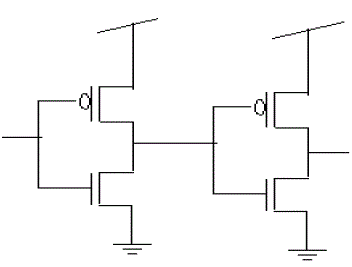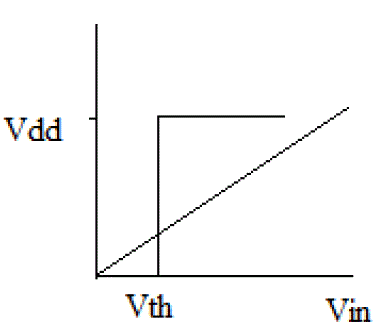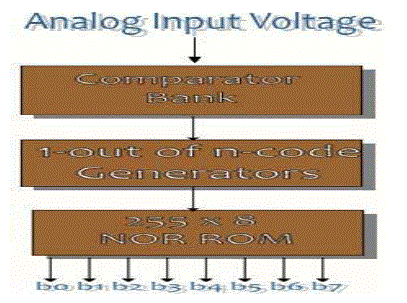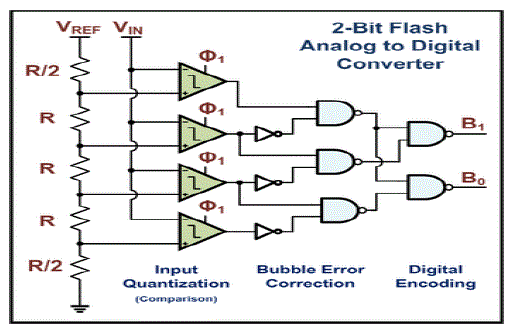The zone of low power and rapid planning of simple to-advanced converters (Adcs) has been a testing issue in the course of the most recent decade. The rate improvement of serial connections and the rising correspondence advances has slanted numerous analysts towards change of force and pace determinations. The significant building piece overseeing these particulars is the comparator. In present day VLSI plan the transistor measuring and scaling has an impressive effect. There are exceptionally fundamental two compels, which needs genuine thoughtfulness regarding the VLSI chip creator are fast and low power utilization. Subsequently in this paper a 8-bit 3 Gs/sec blaze simple to-advanced converter (ADC) in 45nm CMOS innovation is exhibited for low power and fast framework on-chip (Soc) applications.
Keywords |
| Power Dissipation System-on-chip based design, flash ADC, Threshold Inverter Quantization
technique, Modern VLSI design, CMOS process technology. |
INTRODUCTION |
| The processors and ADC outlines nowadays request rapid operation and less power expended building design.
Different architectures of ADC have been proposed via specialists amid the most recent decade with distinctive
resolutions, testing rates, power utilizations and temperature ranges. These Adcs are utilized as a part of diverse
applications from portable specialized gadgets to quantify supplies. Since the execution parameters like
inspecting rate, determination, and force utilization of an ADC is essentially controlled by its construction
modeling, one single ADC sort can't cover all applications. Accordingly, it is critical to appropriately pick an
ADC for every specific application. One of the normally utilized ADC is blaze sort ADC due to the better
tradeoff between its execution measurements. For example, a blaze (parallel) sort ADC structural planning is
essentially utilized for fast and low determination applications. A blaze ADC contains two essential building
squares: comparators and encoder. Comparator piece is utilized for contrasting the info sign and the reference
flag and produced thermo code worth and encoder is utilized for changing over thermo code values as a part of
to advanced yield. ADCs are lined with digital circuits in varied signal incorporated chips; where digital signal
dispensation is carry out. The deliver voltage for digital tools is falling rapidly as the technology scales. |
FLASH ADC |
| Streak ADC obliges distinctive size comparators for the era of thermo code. Here TIQ comparators are outlined
which utilizes two falling inverters as a voltage comparator. The voltage comparators contrast the data voltage
and inner reference voltages, which are controlled by the transistor sizes of the inverters. Henceforth, we needn't
bother with the resistor step circuit utilized as a part of a routine glimmer ADC. The second stage inverter is the
addition supporter, which makes a more keen edge for comparator yields and gives full advanced yield voltage
swing. In an ordinary glimmer ADC, reference voltage is created utilizing a resistor step circuit. Because of
resistor stepping stool circuit the span of comparator is vast furthermore expends more power. A portion of the
principle issues of the ordinary comparator structure are. 21n |
| 1. Vast zone for high exactness |
| 2. DC biasing prerequisite |
| 3. Charge infusion slips |
| 4. Metastability mistake |
| 5. High power utilization |
| 6. Resistor show needed. |
| These issues can be overcome by utilizing TIQ strategy. |
TIQ COMPARATOR |
| An optical comparator (frequently called simply a comparator in connection) is a gadget that applies
the standards of optics to the review of made parts. In a comparator, the amplified outline of a part is
anticipated upon the screen, and the measurements and geometry of the part are measured against
recommended cutoff points. The measuring happens in any of a few ways. The most straightforward
way is that graduations on the screen, being superimposed over the outline, permit the viewer to
quantify, as though an acceptable ruler were laid over the picture. An alternate way is that different
focuses on the shape are lined up with the reticule at the middle purpose of the screen, one after an
alternate, by moving the stage on which the part sits, and an advanced read out reports how far the
stage moved to achieve those focuses. At last, the most mechanically progressive routines include
programming that examines the picture and reports estimations. The initial two techniques are the most
well-known; the third is fresher and not as across the board, however its appropriation is progressing in
the computerized period. |
| It is potential to use conformist ADC structural designs, such as FLASH or interleaved pipeline or consecutive
estimate ADCs, for the connection recipient front-ends. Unluckily, neither of these ADCs is very competent for
the variety of pledge and conversion charge naturally needed for high-end connection receivers. Some related
prior exploration works of planning glimmer ADC utilizing CMOS innovation are recorded as takes after. The
TIQ strategy has been utilized to outline a blaze ADC. The center is on low voltage and rapid outline, with
supply of 1.8v and a change rate of 1.3 Gs/sec. A capacitive Interpolation strategy is utilized for a low power
outline which dispenses with the requirement for a resistor step. The following work presents utilization of
computerized systems rather than simple strategies to overcome comparator balance. In 2002 a normal end
circuit is proposed to lessen the quantity of over-reach enhancers, consequently lessening the force utilization.
An ADC is intended for plate drive read channel applications. The creators utilize a current inserting strategy to
outline an ADC working at 1v force supply. In an alternate release the creators have tended to the issue of metadependability which gets to be vital when working at high inspecting rates. |
CONCLUSION |
| In this paper we search about flash ADC and comparator use of low power design for VLSI design circuit. This
review paper states about how TIQ comparator determine low power of VLSI circuit using flash ADC. Further
lower characteristic size and smaller deliver voltage can be included in the design. The plan has been carried out
in digital 65nm customary CMOS technology. |
ACKNOWLEDGMENT |
| The correspondence author is thankful to all the faculty members of department of Electronics &
Communication, IES College of Technology Bhopal, M.P. and India for continuous support and encouragement.
This is a prospect to establish our technical skill for the advantage of social civilization. |
| |
Figures at a glance |
 |
 |
 |
 |
| Figure 1 |
Figure 2 |
Figure 3 |
Figure 4 |
|
| |
References |
- Jincheol Yoo, “A TIQ Based CMOS Flash A/D Converter for System on Chip Application”, A Thesis in Computer Sciences and Engineering, .2003
- Ali Tangel and Kyusun Choi, “The CMOS Inverter as A Compactor in ADC Design”, Analog Integrated Circuit and Signal Processing, 39 147-155, 2003
- S.S. Khot, P.W.Wani, M. S.Sutaone, Shubhang Tripathi “Design Of A 45 M TIQ comparator for High Speed and Low Power 4-Bit Flash ADC” ACEEE Int. J. On Electrical and Power Engineering Vol.02 No. 01 Feb 2011.
- Omar Gonzales, Jonathan Yu, Georgekorbes” 6- Bit Analog to Digital Converter” Dept. of Electrical Engineering, Son Jose State University.
- R.Jacob Baker,” CMOS Circuit Design, Layout and Simulation” Second Edition Willey IEEE Press 2004.
- Meghana Kulkarni, V.Sridhar, G. H. Kulkarni “The Quantized Differential Comparator in Flash Analog to Digital Converter Design” (IJCNC) Vol.2, No.4, July 2010.
- Jincheol Yoo “A TIQ Based CMOS Flash A/D Converter For System-On-Chip Application” PhD Thesis The Pennsylvania State University, 2003.
- Baker, R. J. (2005) “CMOS: Circuit Design, Layout and Simulation”, IEEE Press Wiley India Edition.
- Torfs, G., Li, Z., Bauwelinck, J., Yin, X., Van der Plas, G., & Vandewege, J. (2011) “ Low-power 4-bit flash analogue to digital converter for ranging applications”, Electronics letters, Vol. 47, No.1, pp.20-22.
- Yoo, J., Choi, K., & Tangel, A. (2001). “A 1-GSPS CMOS flash A/D converter for system-on-chip applications”, In Proceedings of IEEE Computer Society Workshop on VLSI, pp. 135-139.
|